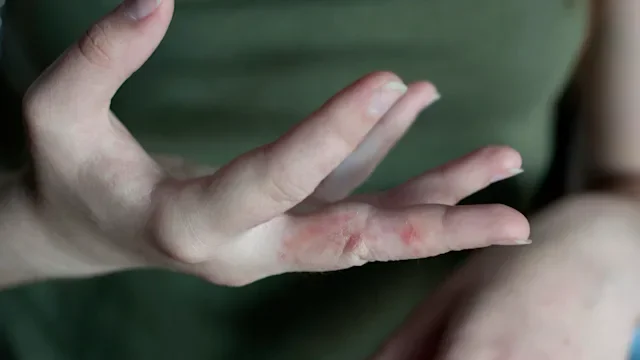Key takeaways:
You can prevent hand eczema by minimizing how often you wash your hands and by using the right hand products.
The best soaps for hand eczema are ones without fragrances, dyes, or irritating chemicals.
More serious hand eczema flares may need prescription creams like topical steroids.
Are your hands always dry and scaly? Do they feel painful, itchy, or sore? If so, you could have hand eczema. And some of your daily habits — like washing dishes — aren’t helping.
But there’s good news. Hand eczema is treatable with careful skin care — and, if needed, some medicated creams. Learn more about what causes eczema on the hands and ways to prevent it.
What is hand eczema?
Hand eczema (hand dermatitis) is a chronic rash caused by skin inflammation on the hands. It’s one of the most common types of eczema, affecting about 1 in 10 people in the U.S. Typical symptoms of hand and finger eczema are:
Dry, chapped skin (often the first sign)
Patches of irritated skin that are red or dark brown
Scaly and inflamed skin
Itching or burning
Blisters under the skin
Deep, painful cracks
Bleeding or oozing
Scabs, pus, and pain
What can cause hand eczema?
Eczema is a rash caused by skin inflammation, but there isn’t a single reason why some people get eczema and others don’t. There are a few different factors to consider.
Eczema happens when someone with a genetic risk for eczema (meaning it runs in their family’s genes) is exposed to risk factors in their environment. These could be chemicals that irritate the skin or cause skin allergies, cold weather, or even stress. Your immune function also plays a part — certain immune system cells are overactive in eczema, causing more inflammation.
People who have eczema as a child are more likely to have it as an adult. They might also have related conditions like hay fever and asthma.
Sometimes, the cause of hand eczema isn’t known, like with dyshidrotic eczema (more on that below).
Hand eczema triggers
No matter what causes your hand eczema, many different triggers can make it worse. The most common triggers include:
Cold temperatures (eczema is common in the winter)
Irritation from soap, fragrances, and other irritants
Too much handwashing, typically in jobs like healthcare, cleaning, and catering
Increased stress
Hand sweating, like from wearing latex gloves
Cold air is tough on eczema. Dry winter weather can strip moisture from your hands, causing flare-ups. Protect skin with thick creams, gloves, and gentle care all season long.
Psoriasis and eczema look different in darker skin tones. Patches may appear violet, gray, or dark brown instead of red. See photos and learn how to spot the differences and treat them safely.
Eczema is more than just itchy skin. It can burn, sting, and keep you up at night. Hear from people living with eczema about what it really feels like — and how they find relief.
Managing eczema naturally: Some essential oils can trigger flare-ups, while others — like coconut and sunflower oils — may soothe and protect skin. Learn which ones help (and which to skip).
What is dyshidrotic eczema (dyshidrosis)?
Dyshidrotic eczema (also called pompholyx) is a type of eczema that causes tiny, itchy blisters to develop on the fingers, hands, and feet. It’s most common in women between the ages of 20 and 40 years. Researchers don’t know what causes dyshidrotic eczema, but it tends to be more common in people with atopic dermatitis (the most common type of eczema).
What does hand eczema look like?
When hand eczema starts, it can be mistaken for dry skin. But there’s a way to tell the difference. If the problem is dry skin, a good moisturizer should be able to fix it. But with eczema, there’s inflammation under the dry skin’s surface. That means you’ll likely have other symptoms along with dry skin (like cracks or blisters). And using a moisturizer alone may not be enough to heal them.
Here are some pictures to help you see what hand eczema looks like.




Tips to prevent and treat hand eczema
To help manage hand eczema, you can add these six simple steps to your routine.
Read more like this
Explore these related articles, suggested for readers like you.
1. Choose the right cleanser
Wash your hands with a fragrance-free soap and avoid using hand sanitizer when possible. Hand sanitizers contain ingredients like alcohol and solvents that can be harsh on your skin.
Don’t forget to remove rings before washing. This is because soap and water can get trapped underneath and cause irritation. See below for more details on what to look for in a hand soap.
2. Avoid hot water
Washing your hands in hot water doesn’t make them cleaner, but it does damage your skin. So use lukewarm water to wash your hands. If you have eczema on other parts of your body, the same also applies to the temperature of your shower or bath water.
3. Be gentle
Avoid rubbing or scrubbing your skin too vigorously. Like harsh soaps and hot water, this can damage the skin and cause inflammation. Dry your hands by gently patting them with a disposable, soft paper towel or tissue.
4. Moisturize all the time
Apply a moisturizer right after washing your hands, while the skin is still damp. This helps to lock in moisture. Reapply whenever your skin feels dry. Here are some other tips for moisturizing your hands:
Use oil-based creams and ointments, which improve skin damage (more on choosing the best moisturizer below).
Keep a tube of moisturizer near every sink and carry one in your bag so you don’t forget.
Overnight, use petroleum jelly on your hands under cotton gloves.
5. Use gloves to protect your hands
Use vinyl gloves with cotton liners for any housework. This includes dishwashing, handwashing clothes, and any time you use antiseptic wipes or cleaning products.
You can also use gloves when shampooing or applying hair products. Wrapping rubber bands around your gloves near the forearm prevents water from getting in. And when outside temperatures drop, wear warm gloves whenever you go outside.
6. Find ways to manage stress
Stress is a normal part of life, and eliminating it isn’t possible. But finding ways to keep your stress levels healthy can help keep eczema flares at bay. Here are some tips to add to your toolbox:
Practice mindfulness and meditation.
Spend time in nature.
Play with animals.
Keep a gratitude journal.
Practice deep breathing.
Move your body.
Lean on your support network.
How to choose a good moisturizer for hand eczema
When it comes to hand eczema, moisturizers aren’t all created equal. The best ones help repair the skin barrier, lock in moisture, and soothe inflamed skin. To get the best results from your moisturizer, look for ones that have some of these ingredients:
Ceramides
Aloe
Glycerin
Lanolin
Petrolatum or vaseline
Mineral oil
You can also search for moisturizers with the “Seal of Acceptance” from the National Eczema Association.
What type of hand soap is best for people with eczema?
For people with hand eczema, using the right soap is an important part of keeping skin healthy and free of eczema. Many soaps have ingredients that can dry or irritate your skin. They can strip away the skin’s natural oils, which disrupts the protective skin barrier. This leads to skin irritation and eczema.
When choosing soap for eczema-prone skin, try to avoid the following ingredients:
Fragrances
Dyes or colorants
Detergents, like sodium lauryl sulfate
Preservatives, like propylene glycol and formaldehyde
But if you’re overwhelmed by choice, or you’re still not sure, search for products that have the National Eczema Association’s “Seal of Acceptance.”
Best treatment for hand eczema
The best way to treat eczema on the hands is to prevent it in the first place. This is because protecting your skin barrier helps to prevent the skin inflammation that causes the eczema rash.
Protecting your skin barrier involves moisturizing your hands frequently and avoiding any irritants that can damage it.
For mild hand eczema flares, over-the-counter (OTC) hydrocortisone can help. Use it 2 to 3 times a day for up to 1 week. This may be enough to control symptoms. But if it isn’t, there are some prescription-only creams and ointments you can try.
Prescription creams for hand eczema
Here are some examples of the best prescription medications for hand eczema:
Steroids: clobetasol, betamethasone, fluocinonide, desoximetasone, or triamcinolone
Calcineurin inhibitors: pimecrolimus or tacrolimus
Phosphodiesterase 4 (PDE4) inhibitors: crisaborole (Eucrisa)
Janus kinase (JAK) inhibitors: ruxolitinib (Opzelura)
Barrier creams: Hylatopic, Levicyn, Neosalus, Epiceram, or Eletone
Stronger medications
In rare cases, medicated creams aren’t enough. You may need to rely on stronger treatments, including:
Steroid pills: prednisone or methylprednisolone
Light therapy: narrowband UVB or psoralen with UVA
Immunosuppressants: cyclosporine, azathioprine, or methotrexate
Biologics: dupilumab (Dupixent)
When should you see a doctor for hand eczema?
If your symptoms are mild, adjusting your skin care practices might be enough. But if you’re struggling to keep on top of your eczema symptoms, you may need professional help.
See your primary care provider or a dermatologist if you notice any of the following on your skin:
Blisters
Redness
Oozing
Scabbing
Cracking
Pain
How to diagnose hand eczema
A dermatologist or other healthcare professional can usually diagnose hand eczema by looking at your hands and asking questions about your symptoms. Sometimes additional tests are needed, including:
Skin biopsy: A dermatologist numbs your skin and removes a small piece of skin. The sample is sent to a lab for examination under the microscope.
Skin scraping: With this test, a medical professional scrapes off a superficial layer of skin cells with a blade. These get examined under a microscope to look for fungal infection.
Patch testing: This test involves applying small amounts of possible allergens like metals, fragrances, preservatives, or rubber chemicals to the skin on special patches. The patches are applied to the skin for a few days and then removed to see if they cause an allergic skin reaction.
The bottom line
Hand eczema is common, especially for people who wash their hands frequently. Too much water and soap can strip away your skin’s natural protective barrier. This can cause irritation and inflammation. Good skin care can protect your skin and provide some relief. Use soaps that are free of fragrances and dyes, and moisturize your hands often.
If your symptoms aren’t improving, prescription medications can help.

Why trust our experts?


Images used with permission from VisualDx (www.visualdx.com).
References
American Academy of Dermatology Association. (n.d.). Dry, scaly, and painful hands could be hand eczema.
Elsner, P., et al. (2019). Hand eczema: Treatment. Journal of the European Academy of Dermatology & Venereology.
Jensen, D. A., et al. (2017). Quantifying the effects of water temperature, soap volume, lather time, and antimicrobial soap as variables in the removal of Escherichia coli ATCC 11229 from hands. Journal of Food Protection.
Kampf, G., et al. (2006). Regular use of a hand cream can attenuate skin dryness and roughness caused by frequent hand washing. BMC Dermatology.
National Eczema Association. (n.d.). About the Seal of Acceptance.
National Eczema Association. (2022). 8 skincare ingredients to avoid if you have eczema, according to dermatologists.
National Eczema Association. (2025). Dyshidrotic eczema.
National Eczema Association. (2025). Moisturizing for eczema.
National Eczema Society. (n.d.). Hand eczema.

















